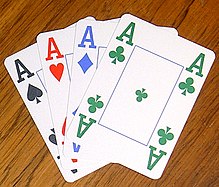| Spades | |
|---|---|
 | |
| Native name | French: Pique |
| Deck | French-suited playing cards |
| Invented | 15th century |
Spades ( ![]() ) (French : Pique) is one of the four playing card suits in the standard French-suited playing cards. It has the same shape as the leaf symbol in German-suited playing cards but its appearance is more akin to that of an upside down black heart with a stalk at its base. It symbolises the pike or halberd, two medieval weapons, but is actually an adaptation of the German suit symbol of Leaves created when French suits were invented around 1480. [1]
) (French : Pique) is one of the four playing card suits in the standard French-suited playing cards. It has the same shape as the leaf symbol in German-suited playing cards but its appearance is more akin to that of an upside down black heart with a stalk at its base. It symbolises the pike or halberd, two medieval weapons, but is actually an adaptation of the German suit symbol of Leaves created when French suits were invented around 1480. [1]
Contents
In bridge, spades rank as the highest suit. In skat and similar games, it is the second-highest suit.













